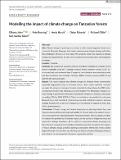| dc.description.abstract | Aim: Climate change is pressing extra strain on the already degraded forest eco system in Tanzania. However, it is mostly unknown how climate change will affect
the distribution of forests in the future. We aimed to model the impacts of climate
change on natural forests to help inform national-level conservation and mitigation
strategies.
Location: Tanzania.
Methods: We conducted maximum entropy (MaxEnt) modelling to simulate forest
habitat suitability using the Tanzanian national forest inventory survey (1,307 oc currences) and environmental data. Changes in forest habitats were simulated under
two Representative Concentration Pathways (RCPs) emission scenarios RCP 4.5 and
RCP 8.5 for 2055 and 2085.
Results: The results indicate that climate change will threaten forest communities,
especially fragmented strips of montane forests. Even under optimistic emission
scenario, the extent of montane forest is projected to almost halve by 2085, inter secting many biodiversity hotspots across the Eastern Arc Mountains. Similarly, cli mate change is predicted to threaten microhabitat forests (i.e. thickets), with losses
exceeding 70% by 2085 (RCP8.5). Other forest habitats are predicted to decrease
(lowland forest and woodland) representing essential ecological networks, whereas
suitable habitats for carbon-rich mangroves are predicted to expand by more than
40% at both scenarios.
Conclusions: Climate change will impact forests by accelerating habitat loss, and
fragmentation and the remaining land suitable for forests will also be subject to pres sures associated with rising demand for food and biofuels. These changes are likely
to increase the probability of adverse impacts to the country's indigenous flora and
fauna. Our findings, therefore, call for a shift in conservation efforts, focusing on (i)
the enhanced management of existing protected areas that can absorb the impacts
of future climate change, and (ii) expanding conservation efforts into newly suitable
regions through effective land use planning and land reclamation, helping to preserve
and enhance forest connectivity between fragmented patches. | en_US |

